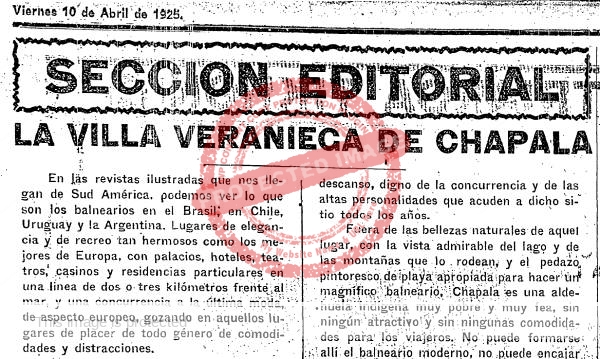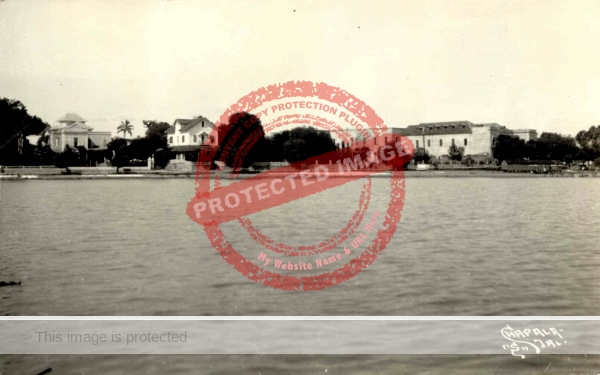In a departure from our normal style, this post looks at a 1925 editorial in the long-running Guadalajara daily El Informador titled “La Villa Veraniega de Chapala” (The Summer Resort of Chapala). Quotes used throughout this post are informal translations of the original Spanish. The most likely candidate for the editorial’s authorship is the newspaper’s then Editor-in-Chief, Agustín Santoscoy. The editorial compared Chapala to holiday resorts and spa towns in South America.
It opened by claiming that illustrated magazines from Brazil, Chile, Uruguay and Argentina showed that their coastal resort towns had a level of elegance—in their “palaces, hotels, theaters, casinos and private residences”— equivalent to the best holiday locations in Europe. The author attributed this ‘success’ to their function as ports, with good links to Europe, and the nature of the adjoining coast:
The coast in those places is not unhealthy, there are no Indians, and the bulk of the civilized population lives on the coast; and, finally, a long period of peace and prosperity allows these towns to have the luxury of wonderful spas.”
The writer then drew a sharp (and nowadays politically incorrect) contrast with Mexico:
In Mexico, the opposite is true: the coasts are wild, sick, full of pests, almost uninhabited and very inaccessible due to a lack of communication routes. On these coasts, the indigenous population, very dark in color, lives indolently in the orchards or in the small towns, and stamps them with its style, offering tourists the shade of palm and petate, thatched lean-tos and shingle-roofed huts on the burning sands of the beach.”

After dismissing Cuyutlán—“the only beach in the Pacific that can be reached by train after a frightful journey full of discomforts”—and Veracruz—where the nortes [strong storms] scare people and blow away awnings, latticework, pergolas, branches and roofs every year—the writer asks where “the rich, the elegant people of the capital, top officials and diplomats” spend their summers in Mexico?
And his answer? Chapala—which is where “you can go without fear and in relative comfort” to find enchanting water and scenery, without having to experience “the hell of the coast.”
The author then described what Chapala was like ‘today’ and suggested steps that the federal government might take to improve the town for the benefit of all visitors, famous and otherwise.

J. E. Sánchez (photographer). Postcard mailed 1924.
Chapala in 1925
Apart from the natural beauty of the place, with its lovely views of the lake and surrounding mountains, and the picturesque stretch of beach suitable for a magnificent resort, Chapala is a very poor and very ugly indigenous village, without any attraction or comforts for travelers. A modern spa cannot be formed there…. There is a lack of walks, squares, space, amusements, bathing facilities, gardens, parks and kiosks for visitors, and nowhere to stay to escape the sun…. while the elegant crowd jostles to crowd together in two small hotels and to occupy a limited part of the beach or in a few chalets that will later be abandoned for most of the year.
The village is made up of shacks, adobe walls, and yards where, during the season, natives swarm to sell fruits, vegetables, and other horribly expensive provisions to earn a year’s income in a week, causing middle-class visitors to leave quickly and never return.”
In order to improve Chapala, the author of the editorial proposed that the federal government should take over certain works, and also stimulate companies and individuals to make improvements. Among the potential improvements suggested were “a direct rail service to Chapala,” “a magnificent paved road for automobiles”, and a “new and modern settlement on the lakeshore” with government-built docks, boardwalks, and bathing areas, along with a “large and sumptuous presidential residence,” all of which would bring advantages that would benefit the town and the general public. These steps were urgent, “since Chapala is frequented by foreign diplomats and tourists,” and because the government should keep “the promises made so many times by officials who, during their stay, have realized the misery and inconveniences of the town.”
Question for readers who have made it this far:
- 99 years on, how much progress has really been made?
Several chapters of Foreign Footprints in Ajijic: Decades of Change in a Mexican Village offer more details about the history of the artistic community in Ajijic.
Lake Chapala: A Postcard History (2022) uses reproductions of more than 150 vintage postcards to unravel the incredible story of how Lake Chapala became an international tourist and retirement center.
Source
- El Informador: 10 April 1925, 3.
Comments, corrections and additional material are welcome, whether via the comments feature or email.
Tony Burton’s books include “Lake Chapala: A Postcard History” (2022), “Foreign Footprints in Ajijic” (2022), “If Walls Could Talk: Chapala’s historic buildings and their former occupants” (2020), (available in translation as “Si Las Paredes Hablaran”), “Mexican Kaleidoscope” (2016), and “Lake Chapala Through the Ages” (2008).
Flat loved this and the, can we say, forthright opinion. Having traveled both coasts of Mexico in the early 1970s–I understand the authors take on the coast although I loved what I found–loved seeing this–thanks-
Thanks, Bill – Anyone who has traveled as much of Mexico as you have must sometimes have encountered places which have—as they say in the modern idiom—’lost the plot.’ Un fuerte abrazo, amigo.